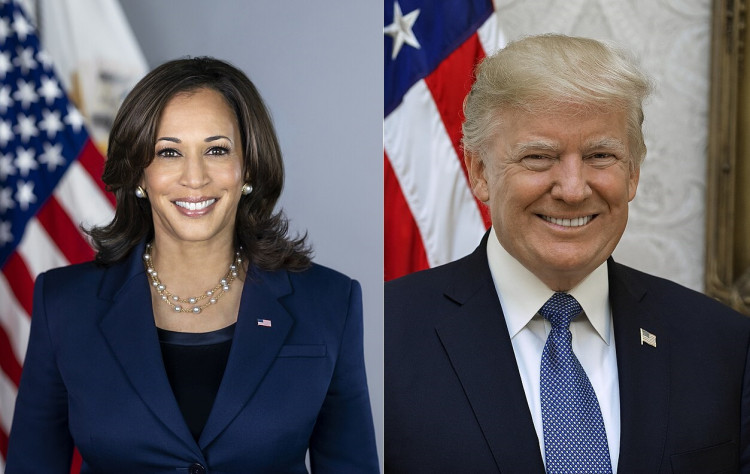As the first and potentially only debate between Vice President Kamala Harris and former President Donald Trump looms on the horizon, the 2024 presidential race is shaping up to be a nail-biter. A series of polls released on Sunday reveal a deadlock between the two candidates, both nationally and in key battleground states, signaling a closely contested election.
In Pennsylvania, a state critical to both campaigns, the latest CBS News/YouGov poll of likely voters shows Harris and Trump tied at 50% each. This poll, with a margin of error of plus or minus 3.5 percentage points, underscores the fierce competition in the Keystone State, where the debate will take place on Tuesday. Similarly, a New York Times/Siena College poll conducted nationwide also places the candidates neck-and-neck, with Trump holding a narrow 48% to 47% lead over Harris, a difference well within the margin of error.
The upcoming debate in Philadelphia could play a significant role in swaying undecided voters, especially as Harris remains less well-known to some segments of the electorate. According to the Times/Siena poll, 28% of likely voters indicated they need more information about Harris, compared to only 9% who said the same about Trump. This highlights the potential impact of the debate on the race, as Harris seeks to introduce herself and her policies to a broader audience.
"Pennsylvania is always going to be close," remarked U.S. Sen. John Fetterman (D-Pa.) during an appearance on CNN's "State of the Union." He emphasized the importance of engaging with voters across the state, even in traditionally Republican areas, to win the election. Fetterman acknowledged the tight race but expressed confidence in the Democratic strategy, which includes extensive campaigning and targeted advertising in key states.
Indeed, both Harris and Trump have made numerous visits to Pennsylvania, reflecting the state's pivotal role in their electoral strategies. Harris, who recently campaigned in Pittsburgh, is set to return to Pennsylvania later this week as part of a broader tour of battleground states alongside Democratic vice-presidential nominee Tim Walz. The Harris campaign also unveiled a new advertisement in Pennsylvania and other swing states, focusing on economic issues such as lowering prescription drug costs and cutting middle-class taxes.
This ad blitz, part of a $58.8 million campaign investment, contrasts sharply with Trump's spending in the state, which trails by about $20 million, according to AdImpact, a firm that tracks political advertising. The massive financial commitment reflects the high stakes of the race, with total ad spending in Pennsylvania approaching $400 million as Election Day draws nearer.
The debate also comes on the heels of a tumultuous period in American politics, marked by unprecedented events that have left the electoral landscape in flux. Trump's campaign has rebounded after surviving an assassination attempt in July, which galvanized support among his base and solidified his standing within the Republican Party. Meanwhile, Biden's decision to exit the race and endorse Harris has unified the Democratic Party, bringing renewed energy and enthusiasm to her campaign.
Despite these developments, the race remains razor-thin. Harris has managed to close the gap that Biden previously faced against Trump, with recent polls showing her slightly ahead in the RealClearPolitics national average. This surge in support is partly attributed to Harris's ability to energize the Democratic base, with 72% of Democrats expressing enthusiasm about voting, compared to 69% of Republicans.
However, the race is far from decided. In key battleground states like Pennsylvania, Michigan, and Wisconsin, the electorate remains deeply divided. Trump holds an advantage among non-college-educated white voters, a demographic that has been crucial to his success in these states. These voters, many of whom feel left behind economically, see Trump as a better advocate for working-class interests.
Conversely, Harris is viewed more favorably on issues such as middle-class economic policies and housing affordability. Despite Trump's stronghold among certain voter groups, Harris is perceived as more "mainstream" compared to Trump, whose positions are often described as "extreme." This perception could play a critical role in swaying moderate voters who are wary of Trump's rhetoric and policy proposals.
As the debate approaches, both candidates face the challenge of not only appealing to their respective bases but also winning over the undecided voters who could tip the scales in this tightly contested race. While Harris has gained momentum in recent weeks, Trump's resilience and ability to dominate the media landscape make this an unpredictable contest.
U.S. Transportation Secretary Pete Buttigieg summed up the stakes of the upcoming debate, noting that Harris's ability to focus on her vision for America's future while countering Trump's provocations will be crucial. "It's an extremely challenging task in the face of all the distraction," Buttigieg said, emphasizing the need for Harris to maintain her message amidst Trump's controversial remarks.
In the end, as Sen. Fetterman pointed out, the choice before voters is stark, and the outcome will likely hinge on which candidate can better articulate their vision for the next four years. "Do we want that kind of chaos and reckless behavior from Trump?" Fetterman asked, or a continuation of the stability and international alliances that he credits to the Biden administration.






